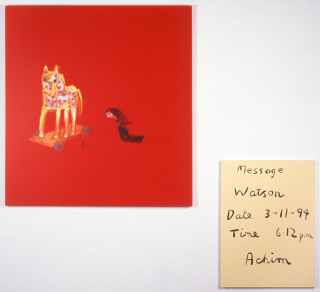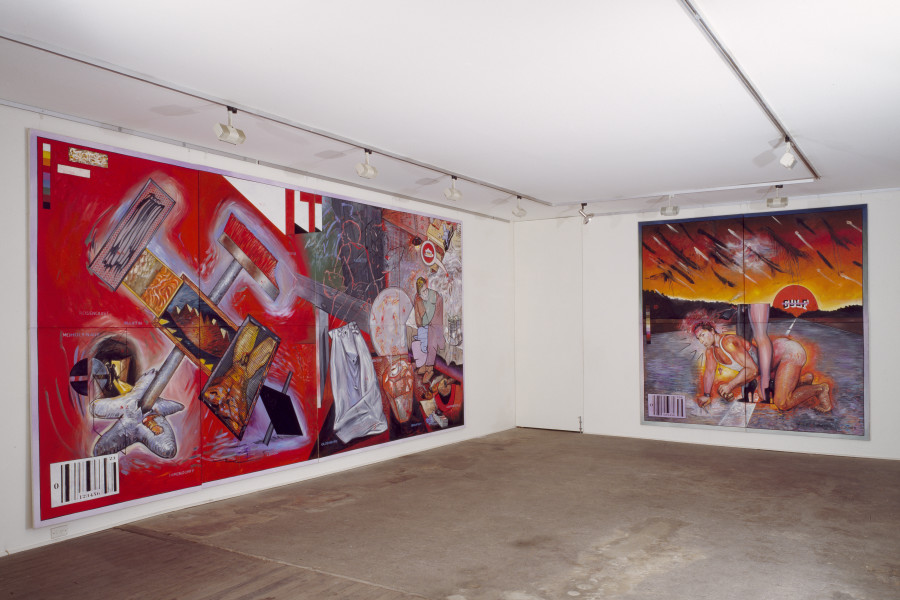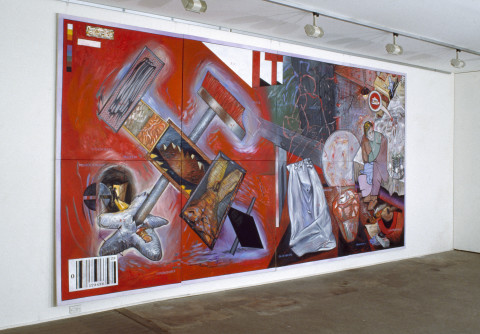The use of quotation by Davila, the over-accumulated references to known works and the self-referentiality he brings to the discourse of painting, emphasises the historical character of the process and the gestation of artistic creation. Thus he proceeds to reformulate the system of conventions, the institutional and codified character of the signs he treats.
Exhibition Dates: 19 September – 5 October 1985
The use of quotation by Davila, the over-accumulated references to known works and the self-referentiality he brings to the discourse of painting, emphasises the historical character of the process and the gestation of artistic creation. Thus he proceeds to reformulate the system of conventions, the institutional and codified character of the signs he treats. This system is in charge of normalising the historical models of perception or consciousness which each artist sets out to transform.
Here Davila affirms that every production of art is based on, and exceeds all the previous ones. The sum of experience inherited from all these productions produces a diachronic relationship between the artwork and its body of practices. The new work is constructed from knowledge of preceding works, works which it convokes in its interior in a dialogical play of interproductive forces. Each work necessitates a rereading and reinterpretation of the series to which it belongs, its given 'tradition'. This is a series which it disintegrates and reintegrates in the course of its production: it is driven by the impulse to reformulate the material and meaning, the language and identity of this series.
Such is the rule of artistic creation which Davila poses in his systematic use of quotation, as a device for deconstructing the language of the artwork. This is why few of his images are unprecedented or original.
The whole process of quotation implies the forging of an unforeseeable unity, from the various statements and fragments of a decomposed unity, into a new field of enunciation. In the passage from one materiality to another in the translation of one support into another, new contextual pressures are applied to the quoted statement in question, whose contours are redefined and whose meaning is reoriented in a new and unprecedented direction.
Davila modifies his quoted material in a number of ways. To begin with, by repainting fragments from the tradition of Fine Art in the primitive manner of popular realism, he remodels them and renovates the stylistic stress given to their respective modes of expression. Here his offhand brushwork, the unfinished surface damages the copy and debases the model by a vulgar reinterpretation of the keys.
But perhaps his main transformation proceeds from placing these statements in a sequence that is not only figurative but narrative as well. This new narrative sequence connects figures both from the History of Art and from his own imagination, uniting them within an irrational, phantasmatic, erotic and delirious order of motivations. All the quoted fragments are relocated in his pictures as narrative elements addressed to a sexual phantasy. This narrative tells the story, metonymically, of a desire; the storyline is held together and staged by the force of the unconscious. The syntagmatic disjunction and conjunction occurring at the level of the pictorial narrative, a syntagm articulated by the conversion of images into fictional motifs, is libidinally charged. Desire explodes in the syntactic disarticulation of quoted statements.
In the series of paintings based on The Kiss (1982), one of the figures quoted (and requoted, since Davila is quoting Lichtenstein who quotes from Picasso) embraces another figure imagined by Davila. The quoting body (Davila) enters into an amorous encounter with the quoted body (culture), symbolising the force of attraction between two
systems of production as well as the erotic or copulative nature of quotation.
—Extract from 'LOVE IN QUOTES' by Nelly Richard
 Group Show, Stockroom
Group Show, Stockroom
Roslyn Oxley9 Gallery, 1995
 Group Show, Photosynthesis
Group Show, Photosynthesis
Roslyn Oxley9 Gallery, 1994
 Juan Davila
Juan Davila
Roslyn Oxley9 Gallery, 1993
 Group Show
Group Show
Roslyn Oxley9 Gallery, 1992
 Group Show, Christmas show
Group Show, Christmas show
Roslyn Oxley9 Gallery, 1991
 Juan Davila
Juan Davila
Roslyn Oxley9 Gallery, 1991
 Group Show, The Cocktail Party (All Gallery Artists)
Group Show, The Cocktail Party (All Gallery Artists)
Roslyn Oxley9 Gallery, 1988
 Juan Davila
Juan Davila
Roslyn Oxley9 Gallery, 1988
 Group Show, 1968-1988 Selected works
Group Show, 1968-1988 Selected works
Roslyn Oxley9 Gallery, 1988
 Juan Davila Quotes from hysterical tears
Juan Davila Quotes from hysterical tears
Roslyn Oxley9 Gallery, 1985
 Group Show, Pirates & Mutineers
Group Show, Pirates & Mutineers
Roslyn Oxley9 Gallery, 1983
 Juan Davila Paintings
Juan Davila Paintings
Roslyn Oxley9 Gallery, 1982
 Juan Davila Stupid as a Painter, 4th Biennale of Sydney
Juan Davila Stupid as a Painter, 4th Biennale of Sydney
Roslyn Oxley9 Gallery, 1982











